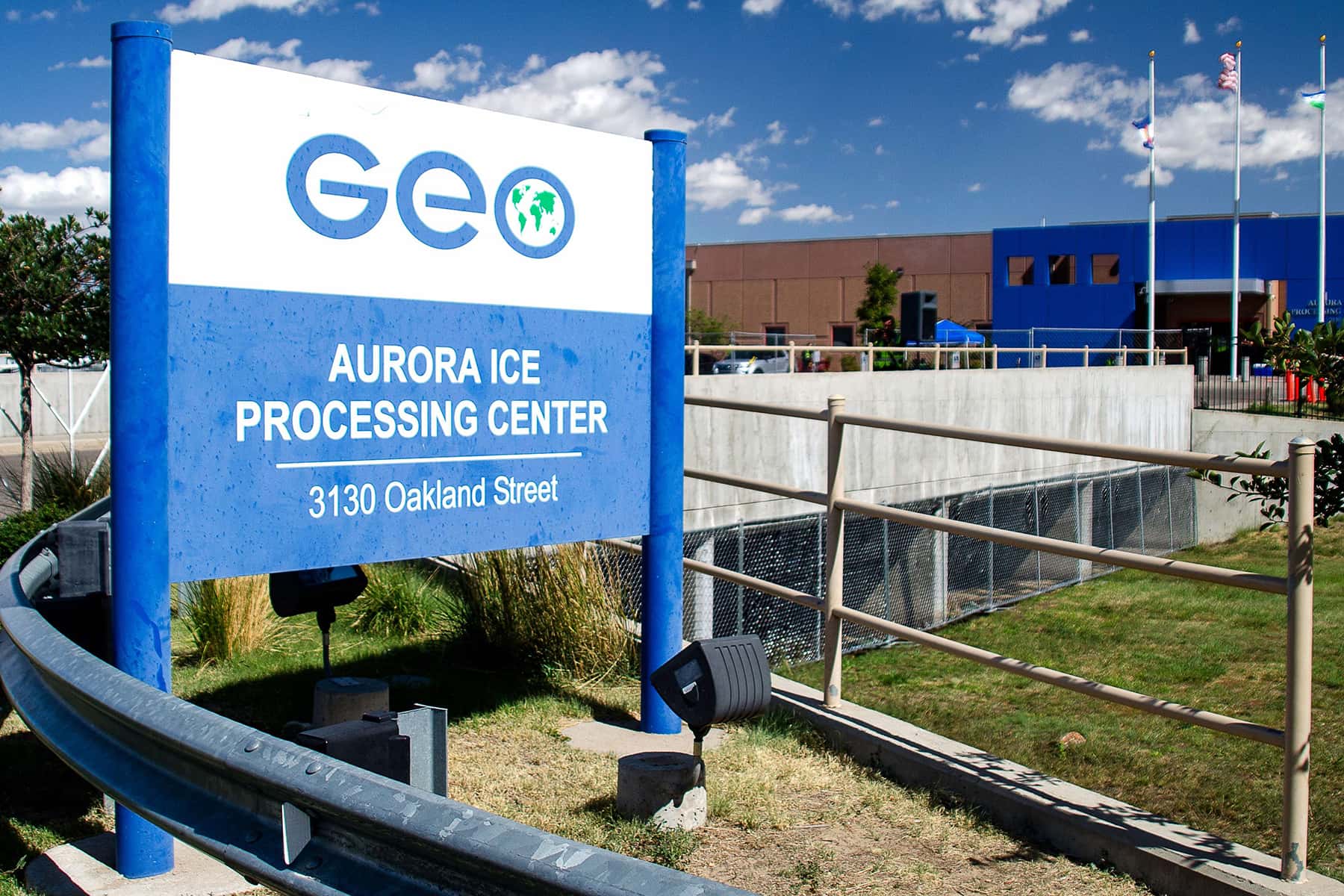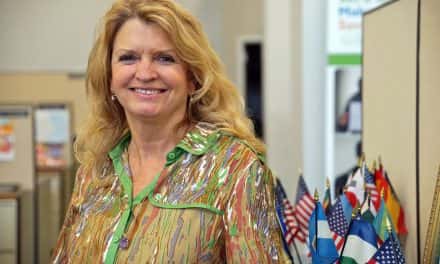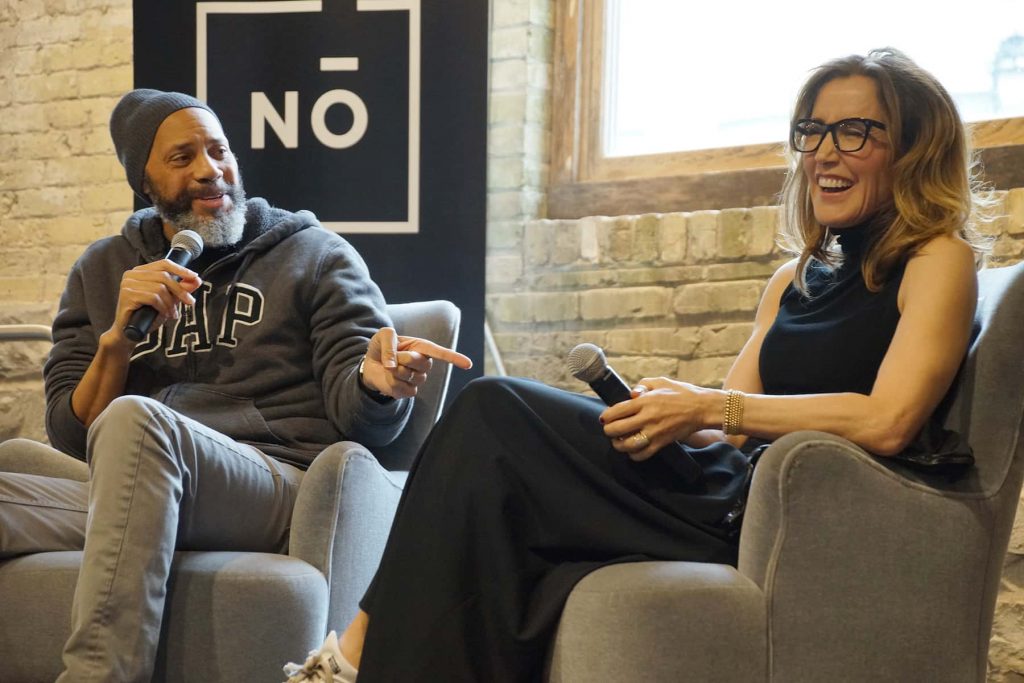
Editor’s Note: A native of Milwaukee, Wisconsin, Maddy Hughes moved to Denver, Colorado to pursue her passion for writing about culture and the arts. After settling into her new community, she attended several Aurora City council meetings, when local residents demanded answers to reports of neglect and maltreatment at the local ICE (Immigration and Customs Enforcement) detention center. The public had also voiced their frustration over former Mayor Bob LeGare’s inaction on the matter. When the coronavirus crisis hit, and news of the high infection rate inside jails spread everywhere, Hughes felt drawn to investigate conditions in ICE detention. At the Federal facility, detainees were not held as criminals, but as people seeking citizenship. Hughes began her reporting by asking why so many immigrants were being forcibly held during a pandemic, especially without any criminal charges.
Since nearly the beginning of the Trump administration’s immigrant family separations in 2017, the ICE Detention Center in Aurora has been the subject of much speculation in the media. The facility, owned by private prison corporation GEO Group, is funded through a high sum in tax dollars and has been found to still overspend its budget. Despite the $7.5 billion that ICE spent in 2018 and $7.6 billion in 2019, there were a list of issues documented by the U.S. Inspector General in 2019 including incidents of mumps and chickenpox spread among inmates. Now, with the COVID-19 pandemic, there are worries that the detention center is a breeding ground for infection.
In September of 2019 the ACLU of Colorado released a report citing human rights abuses and neglect at the facility that led to the deaths of two detainees. Kamyar Samimi, a 64-year-old man who was held in detention for 15 days before he passed, had been on methadone for 20 years and complained repeatedly of severe withdrawal symptoms to nurses. His complaints elicited almost no response. Had Samimi been given his medication, or never been taken off of it in the first place, he would have likely survived.
Evalin-Ali Mandza, 46 years old, was in detention at the Aurora GEO Center in 2012 when he suffered a heart attack in the early morning. Because the ICE nurse on staff did not know how to use an electrocardiogram machine, nor how to read the test results, there was a delay in the decision to call for an ambulance. An investigation by the Department of Homeland Security found that staff also did not use proper Chest Pain Protocol, and Mandza wasn’t given cardiac medication. All these factors “may have been contributing factors to the death of the patient,” per the report.
GEO Group CEO George Zoley seems to believe GEO’s operations are going well. The ACLU report notes that Zoley, who immigrated from Greece to the USA with his family when he was only three, announced in a February 2019 conference call with shareholders that he was “pleased with (GEO’S) overall operational and financial results during the very active fourth quarter of 2018.” During the call, he also proudly shared that the GEO Corrections and Detention unit served over 300,000 individuals in 2018. Net income for the fourth quarter of 2018 was $33.4 million.
Local immigration rights activists disagree about what it means to “serve” inmates in ICE’s facilities. During the COVID-19 pandemic, activists have been concerned about spreading of the virus in detention centers. Ana Rodriguez, community organizer with Colorado People’s Alliance, talks regularly with people in the Aurora facility. At the beginning of the pandemic, inmates told her they weren’t even receiving clean towels.
“They didn’t have anyone doing laundry service. This virus requires excellent personal hygiene. How are you supposed to stay clean and protected if you don’t even have a clean towel to use?”
On March 27th, one of the detainees she talks to regularly told her that GEO guards gave the detainees written notices stating that they would be placed on 23 hour lockdowns in their cells and would be let out in groups so they could “adhere to Governor Jared Polis’” directive for detention centers.
“For weeks, detainees were in their cells around 23 hours a day. The one hour they were allowed out was their only time to call family, attorneys, shower, etc. Some cells were even forgotten to be let out so they were stuck in their cells more than one day. Others were only allowed out 20 or 30 minutes instead of the full hour.”
GEO claimed they were following social distancing guidelines, but at the time, they were keeping six to eight inmates in one cell.
“That literally made it impossible for them to practice social distancing within their own cells for the 23 hours they were locked down per day. Even if they stood in different corners of the cell, they wouldn’t be able to be six feet away from each other,” Rodriguez says.
In response to the news about inmates being grouped together in their cells, community organizations like COPA (Colorado People’s Alliance), AFSC (American Friends Service Committee), family members of detainees, and more allies made noise about the issue. They used social media, press releases, and contacted Congressional offices. After a few weeks, GEO started allowing detainees four hours out of their cells per day instead of just one. They were also spread out so cells had two to three people, but some cells still hold four to six people. COPA pressed Congressman Jason Crow’s office to ask why they couldn’t further spread detainees out and use every single cell.
“They heard back from GEO that they couldn’t share that information because it was contractual with ICE. This made it seem as if they had no control over how spread out people were and it was ICE’s fault because that’s what the contract said.”
And there was still a problem with the schedule inside the facility.
“The problem was that GEO’s schedule was so poorly planned that for several weeks, at least once every few days some of the cells would not be released for 32 consecutive hours. The folks in these cells were released one day from 7:00 a.m. to 11:00 a.m., and would remain in their cells from 11 am until 7 pm the next day when they would be released from 7 pm to 11 pm.”
This issue also required pressure from the outside to change.
“Detainees created an alternative plan in a grievance that they submitted to the Major. They are supposed to hear back within five days. But they were getting radio silence.”
Congressman Crow’s office stepped in at Rodriguez’s request, and asked GEO for information on their release schedules.
“We also published this testimony on our social media and talked about it in our actions. Within a few days of the Congressman’s office asking for GEO’s cell release schedules, I got a message from my detained friend telling me that GEO had reorganized their schedules and they were now being released four hours in the morning and four hours in the evening.”
Rodriguez has been organizing to increase transparency and accountability from ICE for two years now. She says her work, and community pressure, has gotten results.
“The first year was about building relationships and hearing families’ stories, partly through canvassing outside the detention center. In October 2019 a local level ordinance was passed. In December 2019 the Pod Act was passed. And there’s been all of the work done with Jason Crow. Now community members in other places have precedent to use their Congress members to hold GEO accountable.”
The local level ordinance mentioned requires ICE to report contagious disease outbreaks to the fire department. It is intended to protect first responders who may risk their health while visiting the facility on the job. The POD Act (Public Oversight of Detention Centers) allows members of Congress access to detention centers within 48 hours of their request.
Congressman Jason Crow’s office does weekly visits to the Aurora ICE detention center to check on conditions in the facility.
Rodriguez has heard from the fire chief that ICE has been reporting, per the ordinance, during the pandemic. However, she says, “Only two people have been tested. So the ordinance isn’t enough.”
Rodriguez says that in the midst of the COVID-19 pandemic, she hears from people all over with loved ones who are detained.
“Most recently I’ve been hearing from folks in California, Utah, Ohio. People are really panicked about what’s happening to their loved ones during the pandemic. In some cases they haven’t seen them in person since they were brought into the facility.
They call me in desperation, saying, ‘I don’t know what’s happening,’ worried about their loved ones with asthma, saying people are getting sick and could die in there and the guards aren’t doing anything. They want me to check on (their loved ones).”
Rodriguez would like to see a state policy to bring facilities under the responsibility of the state.
“State facilities are important because GEO does not have official inspections. Reports on Congressman Jason Crow’s website are done by his staff, so they’re allowed to go through the kitchen for example and check for temperature of food. But imagine if you were hired onto Crow’s staff and on your first day, you had to go do an inspection of the Aurora ICE detention facility.” In other words, Crow’s staff is not trained for health inspections, especially during the time of a major health pandemic.
“It would be much more thorough if a designated agency, like CDPHE, did it. They would have a laundry list of things they’re inspecting for.”
Can ICE detention centers practice CDC safety guidelines well enough to contain the virus? From Rodriguez’ perspective, it’s not possible.
“Having people in close quarters and in these for-profit detention centers will lead to inefficient care; they will always cut corners and choose the cheaper option versus the humane option. It’s inevitable that they will get sick in these facilities.”
Medically vulnerable detainees are being released early due to a federal judge’s order, and as of Tuesday April 21st, ICE said they had already released 700 at-risk detainees. Rodriguez says this is not enough.
“They have legal authority to use parole and let people go home to their families and continue ICE check-ins. It’s a preliminary injunction, and makes it clear that they’re not using basic tools at their disposal because people are not their priority.” She notes that there are many community organizations whose purpose is to provide direct service; help with placements, plane trips, and post them while this crisis is in place.
“ICE should use every tool they have to get people out, to get them back to their families. That’s what our tax dollars should go to. Owners are making millions of dollars a year off our tax dollars to profit off these detention centers.”
The order that ICE consider releasing medically vulnerable detainees early happened a week after RMIAN (Rocky Mountain Immigrant Advocacy Network), Arnold & Porter, and NIPNLG (National Immigration Project of the National Lawyers Guild) lawyers filed a federal lawsuit to release 14 detainees who were “at severe risk of serious health complications or death should they contract COVID-19.”
Laura Lunn, an attorney at RMIAN, said that their lawsuit was similar to the case that caused a federal judge to order to release vulnerable detainees early.
“That case provides a wonderful framework, this is the first time that something like that is happening,” she said.
Eight of the 14 people in the lawsuit were released the day after the group filed suit. Six were denied release.
“What’s striking about the group of people they released is they are all living with HIV, but they did not release another person living with HIV,” Lunn said. “It’s really hard to say what other factors they could be considering. Four of them have criminal history and two do not. Some of them have criminal history from over a decade ago, and this is civil detention, not criminal custody. None of them are serving a sentence, so there’s not a known end date to their confinement. They are being held before they go to immigration court. The government’s purpose that they go to court is not being met because they can’t go if they’re sick.”
Lunn added that a July 2019 report by the Congressional Research Service titled “Immigration: Alternatives to Detention (ATD) Programs” notes that 99 percent of participants in Intensive Supervision Appearance Program III (ISAP III) showed up for their court hearings. And between the fiscal years of 2013 and 2017, 92 percent of asylum seekers showed up in court to hear the final decision on their claims.
Lunn says that she doesn’t think the federal judge’s injunction is going to be effective.
“Most of our clients have had their parole requests denied by ICE; we don’t believe that they’ll change their minds just because a judge says they need to re-review their cases. We want the district courts to make a ruling where a judge says, ‘Absolutely, you must release them.’ When you boil it down, they are the custodians and they have already decided to hold these people in their custody. The litigators will have to keep going back to court to make sure the judge is enforcing the order. ICE is going to have a conservative reading of that order. We don’t have time for the judge to create more clarity around his order when people’s lives are hanging in balance, we need a judge in Colorado to say their lives matter and they need to get out of ICE custody now.
One of the plaintiffs in the case Lunn worked on, who wished to remain anonymous for the sake of her asylum case, is a transgender woman who came to the USA border on March 13th at the onset of the COVID-19 pandemic. She fled her country of origin “because of the transphobic violence that is criminal and threatened with death by gangs.”
She crossed a bridge from El Paso and requested a number to enter COESPO. She was detained right away and transferred to Montana, then Arizona, finally ending up at the Aurora detention facility. She said that detention had a significant effect on her health.
“For me, it was very traumatizing. I have HIV and I started sinking into a depression and a lot of fear. I felt how my immune system started getting weaker, people with HIV can really feel that. I was very fearful of getting sick. The norms were not good, it wasn’t clean, and too many people were placed together.”
She was lucky to have pro bono attorneys working her case.
“We had to file a lot of grievances against GEO, especially during the pandemic. We had to make a lot of denunciations (against ICE) with attorneys because many of our group of women are HIV positive, so any infection can really harm us in the detention center. There was no cleaning, no detergent. Our immune system was already down from the stress of being detained, so the risk (of contracting) coronavirus was even higher.”
“Seven trans women are still there, two of them have been for over a year. One of them has diabetes. I ask that ICE be more flexible with trans women. All of us carry a lot of hardship and have problems from our home countries. Sharing our stories over and over with officers, I always started crying because every time I have to repeat it, it’s like I have to live it again. They ask us again and again to see if we’re trying to lie. I wish they were more sensitive.”
When she entered the country, she thought she was doing the right thing. “We voluntarily gave ourselves over to immigration, we’re trying to follow the process, we should be treated more sensibly.”
She explained that she doesn’t think detention centers should be the solution for all immigrants. “There should be a different type of detention center. We are all mixed together; people in red jumpers have committed crimes, and (people in) orange jumpers have broken some law, but we’re all in there together. When they arrested me, they treated me like a criminal. I had never been arrested in my life. We were handcuffed in the airplane, like we would try to escape.”
“Everything I experienced with ICE has been traumatizing. I didn’t think it would be that way. For example, another trans woman and myself were singled out by officers and told we needed to go wash our faces. We just didn’t think us having makeup had anything to do with this process. Some guards kept saying you are men, you aren’t women. They would make us take off our bras because we don’t have breasts.”
As an immigrant rights attorney, Lunn’s main concern is the health and safety of detainees. She doesn’t know why more people haven’t been tested for the virus.
“That’s something you should ask ICE. I don’t know why they haven’t tested more people. Anecdotally our clients have noted that many people are coughing, sneezing, have fevers, have difficulty breathing. That’s what’s fueling the fear they experience each day because they see so many sick people around them.
One of our clients has said that there has been intermingling between dorms in the facility. All of the dorms are understaffed because a lot of staff members are not coming to work. One of our clients has one lung as well as asthma, so she could easily die from the virus but she cannot easily control who she’s exposed to on a daily basis.”
She says oversight of the facilities is a band-aid.
“As of April 17th a GEO employee tested positive so that same day they started practicing quarantine inside that pod. But no detained setting is appropriate during a pandemic because it’s impossible to practice social distancing. Even if you make sure no one else is going in and out, staff is coming in and out every day and not wearing PPE. There are still people being detained and brought into the facility by ICE. 20 percent of people infected show no symptoms but still can transmit it. Even if they’re doing temperature checks and telling staff to stay home, it’s not preventing the spread. Vulnerable people will suffer health complications for the rest of their lives. TIME looked at the whole prison system in Ohio and 78 percent of inmates had it. When you boil it down the government has argued that our clients are not better outside detention than in it.”
“Medicine doesn’t support the claims the government is making. Our clients are saying the people bringing them food are not wearing face masks and their food is uncovered. So they say, ‘What risks am I facing just by nourishing my body?’ All the comforts we have through this pandemic are stripped from our clients so emotionally they are better off not in detention.”
During the time of COVID-19, only detainees with added health issues are being considered for early release. But all detainees are reliant on staff to follow CDC guidance, especially because they don’t receive updates on best safety practices themselves, according to Lunn.
“The main outlet people have to understand any of this is through the news and our clients don’t have control over the flow of information that they’re receiving,” Lunn said.
Some detainees still do not have legal representation for their cases in this time of elevated health risk. Claudia Robles, a USA -born citizen, says she has spent $15,000 on legal help for her husband who was detained in November of last year. When his case was denied, she took matters into her own hands.
“On March 17th, Luis was denied his cancellation of removal by a GEO ICE judge. I could not afford a lawyer anymore so I had to help my husband file his own appeal to see if somebody else can take a look at the case and see that the judge made a bad call that my husband should have to leave the country just because she thinks that he’s a bad husband, which he is not. That was her reasoning for denying his cancellation of removal. I disagree, my husband is the rock of our family. He completes us and we feel empty without him with us.”
Claudia and Luis have a four year-old daughter together, and with schools closed until next year due to the pandemic, and her husband detained, Claudia will have to pay for private day care until schools open. Claudia calls herself the “bread-winner” of the family: “I work as a medical assistant in my local urgent care (clinic). I am an essential worker in this pandemic,” she said.
Claudia has no idea when her husband will be released, though she is worried for his health, as he suffers from asthma. “It’s been super hard to have Luis in GEO knowing he gets spoiled food and not enough food. I barely sleep just worrying about his health and well being, especially now that in this pandemic my husband has to share his cell with five other people. If he gets COVID-19, that could be deadly, since it’s a virus that affects his lungs which are already compromised due to his asthma.”
Claudia and her daughter have not been able to see her husband since the pandemic began. “We have no information of when he will be released because he was denied bond twice by the same judge that denied his cancellation of removal. Before the pandemic his visiting days were Tuesdays, Fridays, and Saturdays. My daughter and I went every Saturday to go see my husband since he has been there. The last time we were able to see him, behind glass of course, was on March 8th. My daughter is very sad and tells her dad every day how much she misses him and misses seeing him even though it was behind glass. She never understood why she wasn’t able to hug and touch her father, why she had to talk to him through glass and hear his voice through a phone.”
Claudia may have to wait through the whole pandemic for Luis to be released.
“We’re waiting to hear if his case is going to be able to be appealed. They told us that it could take six months to a year for a response, which means my husband would have to be in detention that whole time until we heard back to see if his case would be able to be appealed. We are trying to do a humanitarian parole right now for him but it seems that GEO has been returning all the legal documents that I’m trying to send my husband so that he can apply for humanitarian release due to having asthma. Hopefully soon this information will finally get to him and he will be able to file for humanitarian parole and be able to come home until we can hear from the appeal.”
For the foreseeable future, detainees, their families, and immigrant advocates will be counting on the mercy of ICE to release those on the inside with added health risks.
When asked for comment, Pablo E. Paez, Executive Vice President of Corporate Relations, replied, “As a service provider to the federal government, we would refer you to U.S. Immigration and Customs Enforcement for specific answers to your questions, as well as the agency’s latest guidance on COVID-19. Our company has taken comprehensive steps to address and mitigate the risks of COVID-19 to all those in our care and our employees as detailed in our public statement at geogroup.com/COVID19.”















